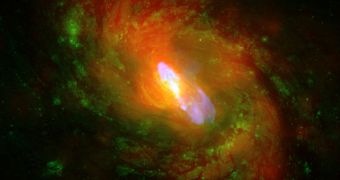For many years now, astronomers have known that large galaxies grow at the same time the supermassive black holes at their cores do. This correlation has made many propose that a link may exist between the two, in the sense that these events influence each other. But thus far no definitive proof of this has been obtained. New observations have, however, confirmed this hypothesis, showing evidence of strong winds in the immediate vicinity of a black hole in a neighboring galaxy. The new datasets were collected using the NASA Chandra X-ray Observatory, Space Fellowship reports.
According to the investigators behind the new study, the findings seem to indicate that even the most common supermassive black holes play a critical part in the development of the galaxy they inhabit. Responsible for these events are the jets of matter that are expelled from the event horizon, rather than the cosmic dust and gas that gets gobbled up on a regular basis. These “black hole blowbacks” were analyzed with the goal of determining whether they have sufficient power to cause long-lasting changes in their surrounding galaxy or not.
Previous studies have already determined that this is indeed the case for some of the largest black holes ever discovered, such as the ones in the Perseus Cluster. But the question was whether the “common” black hole could to the same. Relativistic jets of lower intensity have been observed a lot more often than their super-powerful counterparts. “We’re more interested here in seeing what an 'average'-sized supermassive black hole can do to its galaxy, not the few, really big ones in the biggest galaxies,” explained Massachusetts Institute of Technology (MIT) expert Dan Evans.
The researcher presented these findings in Kona, Hawaii, at the meeting of the High Energy Astrophysics Division of the American Astronomical Society (AAS). He mentioned that the data on which the new conclusions were based were collected with Chandra over a period of five days, as the research team was investigating the nearby galaxy NGC 1068. This structure contains an expanding black hole, which is currently in the midst of a fast-evolving growing process. The central structure at the core of NGC 1068 is estimated to have only twice the weight of the one in the Milky Way, which is a fairly common size.

 14 DAY TRIAL //
14 DAY TRIAL //